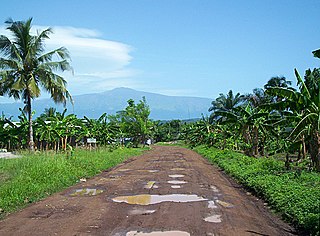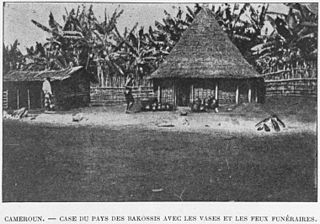
Tiko, originally called ‘Keka’ by the Bakweris, is a town and important port in the southwest region of Cameroon. The settlement grew as a market town for Duala fishermen, Bakweri farmers and hunters from Molyko, Bwenga, Bulu and Bokova. The core quarters in Tiko include Streets 1 to 7, Motombolombo, Down Beach, New Quarter, P&T quarters, New Layout, Long Street, Likomba, Golf Club, Mutengene, Ombe. As of 2010, the town is estimated to have a population of 55,914.

Ndian is a department of Southwest Region in Cameroon. It is located in the humid tropical rainforest zone about 650 km (400 mi) southeast of Yaoundé, the capital.
Mundemba is a town in Southwest Region, of Cameroon and the capital of the Ndian Division. The headquarters of Korup National Park are located in Mundemba. The separate village of Manja is nowadays practically an extension of Mundemba.

Lake Barombi Mbo or Barombi-ma-Mbu is a lake near Kumba in the Southwest Region of Cameroon. It is located in the Cameroon volcanic chain, and is the largest volcanic lake in this region. It is one of the oldest radiocarbon-dated lakes in Africa, with the youngest lava flow in it being about one million years old. On old colonial maps the area was known as Elefanten Sea, but the elephants living in the area were extirpated due to ivory trading.
Tombel is a town and commune in the Southwest Region of Cameroon, in the north of the Mungo Valley. The town is traditionally part of the Bakossi people's country, but now has a significant population of other tribes from other regions of Cameroon.
Bankon is a Bantu language spoken in the Moungo department of the Littoral Province of southwestern Cameroon. It has a lexical similarity of 86% with Rombi which is spoken in the nearby Meme department of Southwest Province.

The Bakossi people are a Bantu ethnic group that live on the western and eastern slopes of Mount Mwanenguba and Mount Kupe in the Bakossi Mountains of Cameroon. They number about 200,000, mostly engaged in subsistence farming but also producing some coffee and cocoa.

Mundame or Moundamé is a community in Cameroon, in the Southwest Region, about 2 kilometres (1.2 mi) from the Mungo River. The river is navigable south of Mundame for about 100 kilometres (62 mi) as it flows through the coastal plain before entering mangrove swamps, where it splits into numerous small channels that empty into the Cameroon estuary complex.

The Rumpi Hills are an undulating mountain range with its highest peak, Mount Rata about 1,800 m (5,900 ft) located between the villages of Dikome Balue and Mofako Balue, Ndian division in the Southwest region of Cameroon. The hills are situated at 4°50’N 9°07’E, cutting across four local councils, with the eastern slopes in Dikome Balue, southern slopes in Ekondo Titi, western slopes in Mundemba, and northern slopes in Toko local councils respectively. These hills are located about 80 km (50 mi) north of Mount Cameroon; about 50 km (31 mi) west of the Bakossi Mountains and some 15 km (9.3 mi) southeast of the Korup National Park.
The Bafaw people are Bantus and live in Meme division of the South West Region of Cameroon. They make up 10 towns or villages, namely: Kokubuma, Kombone Bafaw, Dikomi, Kurume, Bolo, Ikiliwindi, Mambanda, Kumba, Dieka and Njanga each ruled by a chief known as “Nfon.”
Kurume is a town and commune in Cameroon located along the Kumba - Mamfe road in the Southwest Region. Kurume is a place in Konye commune, Meme department, Southwest Region, Cameroon. It is located north of the city of Kumba. The inhabitants speak the Bafaw form of the Bafaw-Balong language.

The Anglophone Crisis, also known as the Ambazonia War or the Cameroonian Civil War, is an ongoing armed conflict between Cameroon Armed Forces and armed separatist groups, part of the long-standing Anglophone problem. Following the suppression of 2016–17 protests by Cameroonian authorities, separatists in the Anglophone regions launched a guerrilla campaign and later proclaimed independence. Within two months, the government of Cameroon declared war on the separatists and sent its army into the Anglophone regions.
This is a timeline of the Anglophone Crisis during 2018.
This is a timeline of the Anglophone Crisis during 2019.

The Oroko are an ethnic group in Cameroon. They belong to the coastal Bantu group, widely known as Sawa, and primarily occupy the Ndian and Meme divisions of the Southwest Region of Cameroon. The people predominantly speak Oroko, English, and Cameroon Pidgin English. The Oroko are related to several ethnic groups in Cameroon's coastal areas, with whom they share a common traditional origin, and similar histories and cultures. These include the Bakweri (Kwe), Bakole, Duala, Ewodi, the Bodiman, the Pongo, the Bamboko, the Isubu, the Limba, the Mungo, and the Wovea.
The Balondo-ba-Konja are a central West-African people whose civilization is situated along the southwest maritime coast of Cameroon. Their origins can be traced back to the early civilization along the banks of the Nyanga and Luapula rivers in the modern Democratic Republic of Congo. The local social structure is matriarchal with extended family support. Their language is Londo, part of the Congolese-Efik linguistic group. They practice a creationist religion in which the supreme being and creator is Ovase Loba.
This is a timeline of the Anglophone Crisis during 2021.
This is a timeline of the Anglophone Crisis in Cameroon during 2022.
This is a timeline of the Anglophone Crisis in Cameroon during 2023.
This is a timeline of the Anglophone Crisis in Cameroon during 2024.





















